SIDO Lyon 2024
18-19 SeptemberLyon, France
Expo
A Tele2 IoT White Paper
The term ‘Smart Cities’ first gained traction back in the 1990s, when it was adopted as a way to illustrate the use of technology and innovation in urban development. Since then, the world has become increasingly urbanized.
As of 2020, 55% of the world’s population lives in urban areas, and that number is expected to increase to nearly 70% by 2050.
This rapid urbanization will put increased pressure on resources, and the demand for intelligent, sustainable environments that address the needs of citizens whilst also offering a high quality of life will escalate.
While smart city projects have, until recently, been largely ad hoc, we are now seeing the emergence of the first truly connected cities, with everything from smart parking and smart traffic management to smart street lighting and smart waste management becoming the norm, rather than the exception. These cases combine a mix of enhanced efficiency and higher quality of living with reduced costs and urban problem solving – all leading to a better quality of life for urban dwellers.
That said, the smart city concept offers different opportunities for different cities, meaning the needs of cities in developing countries may not be the same as their more developed counterparts. According to the United Nations, the immediate need for everyone is to provide adequate urban infrastructure, and in the process of meeting those demands smart infrastructure applications may provide the way for developing cities to achieve leapfrogging through technology.
The advent of 5G will accelerate the adoption of smart city technology, enabling higher speeds, greater data transmission, and better performance. 5G will allow a massive increase in the amount of data being exchanged and embedded sensors will become pervasive. The result will be information on everything from air quality and traffic patterns to the amount of trash in bins.

Additionally, the Covid-19 pandemic has laid bare the need to decrease or remove human intervention, bringing together technology, government, and society to enable a smart economy, smart mobility, smart living, smart governance, smart healthcare, and a smart environment in order to address the rapidly changing needs of society.
While there are myriad areas where IoT technology will have an impact on the development of smart cities, there are some that stand out:
Whether you’re talking about buses, trains, trams, or ferries, public transportation is a solid indicator of just how smart a city can be. But while public transport is better for the environment and infinitely cheaper than using your private car every day, there are a number of factors working against it, including lack of convenience, speed, and sometimes comfort. Unexpected events can disrupt schedules and public transport is not always the most direct way of getting from point A to B.

That said, any perceived drawbacks of using public transportation are quickly being eliminated through the use of IoT technology. Not only is public transport increasingly comfortable, things like free WIFI are making people’s journeys more time effective. Additionally, IoT is enabling operators to not just fine tune schedules and routes, but also keep the public up-to-date on delays or other unexpected events.
As the technology continues to improve, connected public transport systems will also up their game with vastly improved responses to various short term and long-term challenges.
The bus was supposed to arrive at 9.10 but it’s already 9.20 and there’s no bus in sight. It’s one of the great frustrations of using public transport, particularly if you’re standing out there in less than favorable weather, and know you’re running late.
The inability to get real-time information about where the vehicle is or when it will arrive is where IoT makes a big difference. Through the use of tracking technology, data is transmitted back to central command, which can then display information on connected digital signs, as well as send it to the app on your phone. This is particularly helpful before you head out the door – if the bus or train is running late you can get alerts on your phone and either choose another mode of transport or otherwise modify your journey.
Sometimes there are unavoidable delays that disrupt public transport, such as accidents, inclement weather, breakdowns, or road closures.
Through the use of IoT, command centers can respond in real time by re-routing vehicles, notifying passengers via mobile apps, and alerting them to alternative transport options.
This not only minimizes inconvenience for riders but also helps reduce congestion and maintain overall system efficiency. By leveraging real-time data, cities can offer a more resilient and responsive public transportation network that adapts quickly to changing conditions.
Additionally, data allows for the development of contingency plans, such as when train service is disrupted. Information gleaned from scanned travel cards helps pinpoint the average flow of passenger traffic at any given time on any given line, which allows officials to plan alternative transport options, such as buses, thus reducing inconvenience and keeping the city moving by relaying accurate information to passengers.
Integrated ticketing and automated fare collection keep things running smoothly, while also allowing public transport agencies to identify individual travel patterns, such as which stations or routes commuters prefer. This information means they can send personalized information, such as letting a passenger who regularly uses Station X know that in the coming days there will be delays and offer alternatives.
IoT technology allows transit officials to implement driver authorization on its fleet, as well as monitor speed, alertness, starts and stops, route deviations, hard cornering, accelerating and braking, turnaround time, and myriad other driver behaviors. This lifts the level of safety on public transport and allows public transport officials to pinpoint where there is a need for training or other improvements.
Public transport agencies can monitor critical infrastructure and develop plans to address any challenges or improvements that need to be made, while also minimizing disruption and improving system capacity. If a particular train line will be out of service for repairs, agencies can develop plans for alternative routes well ahead of time, while also alerting passengers of the changes.
Self-driving cars are not quite yet a reality, but autonomous public transport is already here. The first driverless metro system was inaugurated in Kobe, Japan in 1991, and today there are 63 fully automated operation lines in 42 cities across 19 countries. According to the International Association of Public Transport (UITP), there will be more than 2,300 km of fully automated metro lines globally by 2025 – and the benefits are clear: safety, flexibility, punctuality, and cost efficiency.
How IoT Enhances Public Transport:
As cities become more congested the need for efficient, cost-effective, and responsive public transport will continue to grow. Through IoT-enabled technology, public transport agencies will continue to improve passenger experience through real-time vehicle tracking, improved responses to unexpected events, personalized travel information, and enhanced driver behavior. The benefits are clear: reduced emissions, happier passengers, and a more streamlined city.
For further reading on how IoT enhances public transport operations, our case with Västtrafik illustrates how Sweden’s Gothenburg region has successfully used IoT to streamline regional public transport services.
With water scarcity predicted to impact nearly 20% of the global population by 2025, the need to effectively manage water resources is more pressing than ever.
According to the United Nations (UN), water scarcity will not just impact humans, it will also have a negative impact on the rest of earth’s inhabitants, as well as economies, whole ecosystems, and even geopolitical stability. To put it another way, by 2025 roughly two billion people will suffer as a result of water scarcity.

Smart water systems use IoT technology to not just halt the spread of water scarcity, but to also help undo the damage that careless usage of water resources has already caused. Smart water systems bring transparency and improved control over the entire water supply chain, from freshwater reservoirs to wastewater collection and recycling. Optimizing water treatment, production, distribution, and consumption will help conserve this most precious of resources.
One of the biggest challenges in water management is determining the amount of water any particular city will need each day. By tracking the history of usage on any given day, historical data and predictive analytics in combination with the consideration of special events, holidays, and weather patterns, give authorities the ability to determine the amount of water consumption they can expect on a particular day. Once they have determined the overall consumption, it is far easier to maintain the correct level of water reserves.
Smart meters and monitoring systems improve operations and processes, while also helping cities reach sustainability and budgeting goals. Measuring real-time water consumption helps identify excessive usage and waste. Usage patterns can be identified and predictions about future consumption can be identified. Real-time monitoring can also help reduce management costs, lower infrastructure costs, and lessen or remove human intervention.
The data generated by sensors allows end-to-end management of the water supply chain, revealing key insights into changing conditions that impact both water resources and the equipment used to deliver it across the chain.
Areas where sensors can play an important role:
Predictive maintenance is one of the best ways to reduce unscheduled downtime and prevent unnecessary repairs. Monitoring pipes, pumps, storage containers, and other machinery and equipment provides valuable insights into wear and tear, allowing for repairs and maintenance to be scheduled at an optimal time with minimal disruptions. By addressing potential breakdowns early, disruption to city life is minimized and there is increased conservation of resources and energy.
When the irrigation process is based on automated scheduling patterns – where it happens at a particular time and for a fixed duration – there is water waste. Automated distribution systems use environmental sensors and precision algorithms to provide automatic water supply to the endpoint. When it comes to smart irrigation, this can mean sensors that read soil moisture, air humidity, and crop conditions are able to deliver just the right amount of water needed.
Water utilities are facing huge challenges due to increased urbanization, higher demand, increased costs, and ageing distribution networks. Smart water management represents one of the most promising yet underused Smart City applications. An IoT-based integrated water management solution can manage most water-related assets in real-time. When implemented on a large scale, data-driven water management can significantly reduce demand and costs while also helping cities meet the needs of their citizens.
To read more about the role IoT sensors play in water management, read our case with Wideco, which uses IoT to monitor district water pipe lines. You can also learn more about LTE-M, the technology designed specifically for IoT and remote assets.
The energy sector is undergoing a massive transformation. Renewable energy has the potential to reduce climate change and air pollution, leading to improved health and the creation of more job opportunities. In April of 2019, energy generated from renewable resources, such as wind, solar, and hydropower, exceeded the total output from coal-powered electric plants for the first time. IoT has been a main driver in that transformation through connected sensors and the data generated, which enable energy companies to better manage an increasingly complex and layered grid.
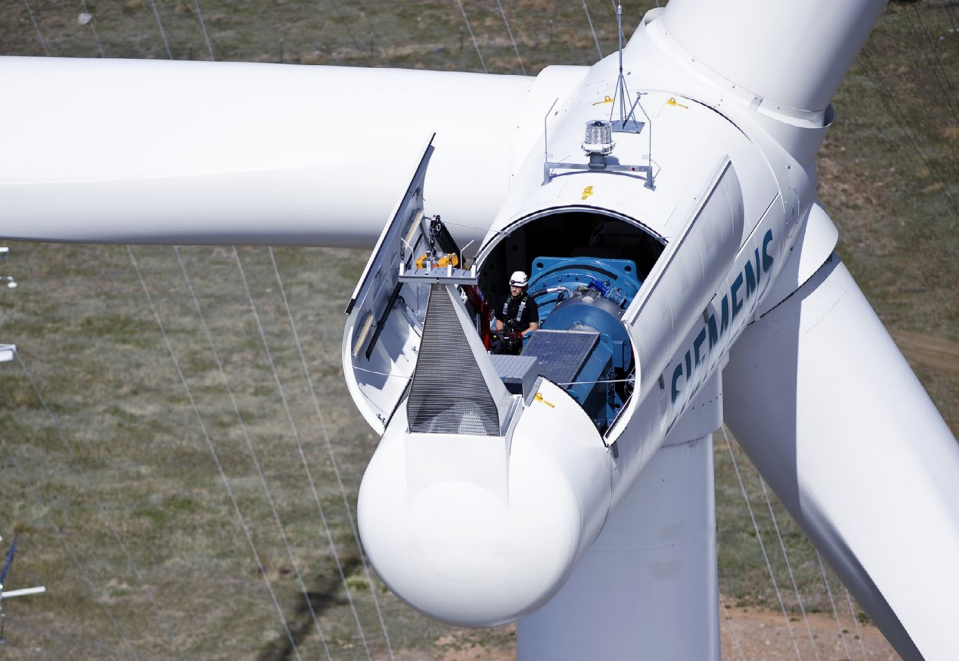
Embedding IoT sensors in generation, transmission, and distribution equipment helps energy companies to monitor and control equipment remotely and in near real-time. This reduces operational costs and lowers dependency on already limited resources.
Sensors measure various parameters, such as temperature and wear and tear, which helps optimize maintenance schedules. Preventative maintenance helps keep equipment up and running by providing for the opportunity to make repairs before there is a failure. This improves reliability, reduces costs, and makes better use of resources. Remote sensors also enable virtual troubleshooting.
Safety is also improved through remote monitoring and management, leading to early detection of failures or damage, which might otherwise result in fires or explosions if left undetected.
One of the biggest hurdles in harnessing renewable energy is efficiency, particularly for methods that depend on variable resources such as solar and wind. IoT devices improve efficiency by detecting the most favorable conditions for energy production, allowing for the equipment to be adjusted accordingly in order to generate maximum output. And real-time data helps minimize wastage.
If we look at wind turbines, analyzing the data generated means the direction of the turbine can be changed to gain maximum efficiency. When it comes to solar power, the direction of solar panels can be changed in order to best capture the energy source, resulting in maximum utilization. While these changes can be done manually, automating them maximizes energy production, and increases efficiency at power plants. This increases power output, reduces operating costs, and improves safety.
Integrating IoT technology into the energy grid enables not only a more distributed system, it also improves overall grid management.
Sensors placed at substations and along distribution lines means data on real-time power consumption can be gathered – and that data can be used to make decisions about things such as load switching, voltage control, and network configuration. Data on usage can be used for forecasting and managing overloads along transmission lines, as well as ensuring plants adhere to regulations and other requirements. Additionally, power consumption data can be used to make decisions about where to build new infrastructure or when to make upgrades on existing ones.
Sensors can also provide real-time alerts about outages and allow workers to quickly turn off power to damaged lines, which in turn prevents possible hazards, such as wildfires or electrocution. Some of these decisions can be automated, which will increase efficiency. If there is an outage, smart switches can isolate the problem automatically and power can be rerouted. This saves both time and human resources.
When it comes to renewables, capacity is growing rapidly, with businesses and homeowners now able to generate their own electricity via solar panels on their rooftops or even building small wind turbines on their property. This increased distribution is a major change and means energy companies must manage not just a few large generators but also a growing number of small generation resources across the grid. While this can present a challenge, smart grid technology will be instrumental in enabling these changes by providing information to operators who can then more precisely manage demand.
IoT doesn’t just provide valuable information to utility companies – it also keeps customers informed about their energy usage. Smart meters collecting usage data can send that information to both utilities and customers.
Additionally, smart devices installed in homes or commercial buildings can measure the power consumed by individual appliances and machines. That information can be used to reduce energy consumption and also reduce energy bills. Other IoT devices, such as smart thermostats, automatically optimize to reduce energy consumption.
Rising energy costs and sustainability can be addressed by connecting, managing, and securing devices that generate data, which in turn gives valuable information that can then be used to optimize grids, control costs, keep customers informed, and increase the safety of both workers and the public.
For further information on IoT and utilities, please read our article on Better Utility Management with IoT.
While the growth of smart cities is providing the necessary infrastructure to increase public safety, most smart city initiatives don’t have public safety as a starting point. Instead, more tangible issues, such as traffic and parking, are where smart cities first kick off.
Many cities are realizing that by building a smart city infrastructure they are also creating an environment that can keep their citizens safe.
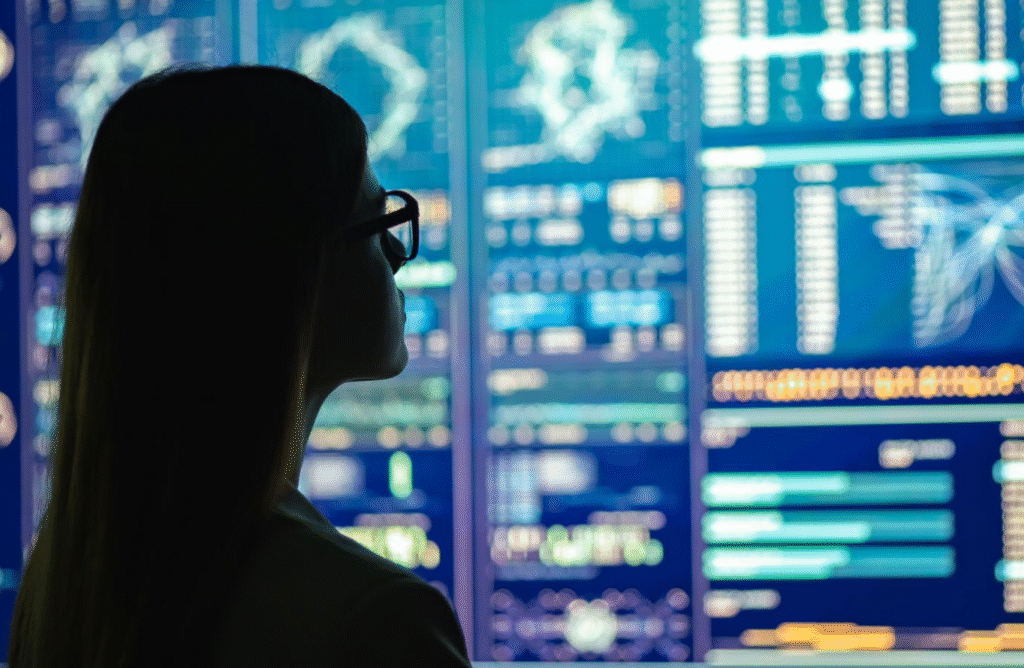
According to a report from the UK, an IoT enabled police force leads to increased efficiency and enhanced public safety. IoT can help with crime detection, evidence gathering, and prevention, while also utilizing tools such as wearables to ensure police protocol.
If we look at crime detection and evidence gathering, many homes have security cameras installed. Now, cities are giving citizens the option of connecting their home security cameras to the city’s system, thereby enhancing the ability to not just detect crimes, but to also solve them. IoT is also making it easier and faster to gather evidence from a wide and sometimes unexpected range of sources, such as in the infamous “Fitbit Murder”, where the victim’s Fitbit helped pinpoint the circumstances of her death and the exact time.
Police forces are also moving towards a more data-driven approach when it comes to predicting and preventing crime. Real-time data can be captured from a variety of sources, including cameras and sensors. Not only does real-time data allow for rapid response, it also allows for historic data to be analyzed to create ‘heat mapping’ systems that help identify criminal hotspots and predict when and where crime may occur.
The use of bodycams and audio is fairly entrenched in many law enforcement agencies and have proven to be beneficial in a number of ways. They provide recordings of exactly what has happened during an incident, which is helpful for both the police and for citizens who interact with them by providing for accountability, and they also record an officer’s vital signs, such as blood pressure and heart rate. This last bit of information can be used to alert dispatchers to signs of trouble.
IoT-enabled guns record exactly when and how a weapon was used, capturing critical evidence. Sensors can include a number of authentication forms to ensure only the authorized person can activate the firearm, and they can also automatically trigger an officer’s bodycam to start recording if the gun is drawn.
Drones provide a new level and quality of surveillance and can be used in, among other things, suspect chases, search and rescue operations, and event management. They can also be used to monitor areas where there is increased risk.
Monitoring crowded public spaces such as shopping areas, transport hubs, sports and entertainment events, and even busy streets for potential safety issues can be challenging.
Smart crowd monitoring combines multiple technologies to manage crowd dynamics, enabling law enforcement and other security personnel to continually be on the lookout for potentially harmful situations and objects and enable law enforcement to improve situational awareness and manage crowds more effectively. This includes everything from detecting potential threats to optimizing the flow of event traffic. The introduction of 5G will drive technological advances further.
CCTV equipped with facial recognition software can identify and track Persons of Interest (POI), as well as flag unusual or violent behavior, in real time. This gives police and security personnel added lead time in responding and addressing potentially harmful situations.
Connected infrared cameras can track crowd density, allowing security teams to react to potentially dangerous situations before they get out of control. Connected scanners can detect certain materials and shapes, alerting police to potential explosive devices. The scanned footage can then be analyzed in real-time in order to determine whether the objects present any danger. If there is danger, personnel can be quickly dispatched to take further action. Gunshot detection devices can register when a gun is fired and where – and can even detect its caliber.
Connected motion sensors monitor traffic patterns, allowing cities and event venues to identify areas that are overcrowded or on their way to becoming overcrowded and distribute resources accordingly. Data gives insights into when and where crowds are likely to move, which allows for planning everything from street closures to distribution of security personnel.
When all of these smart crowd monitoring technologies are integrated in situational awareness platforms, public safety is enhanced, both short and long term.
Access control is the secure management of people as they move through a building or site, ensuring control over who is able to enter approved areas and when.
Modern access control systems allow administrators to specify schedules and access levels for employees, clients, vendors, and special events, etc., and generate alerts about suspicious activity while gathering data for further insights. It is flexible and dynamic and enables security staff to authorize or revoke permissions when needed.
Any organization that has areas or assets they want to limit access to or where there is a need to audit who goes where and when can benefit from an access control system. Banks, power plants, travel hubs, government data centers, event venues, and military bases are among those, but even offices and schools are either already using these systems or are considering implementation.
There are myriad other areas where IoT improves public safety, from smart streetlights equipped with motion sensors that respond when a person is in the area to bridges, where sensors of various types—accelerometers, strain gauges, weigh-in-motion devices, and temperature sensors—measure everything from wind speeds to structural integrity. This is particularly important when you consider that one in nine bridges are considered ‘structurally unsound’ in the US alone. Through the use of IoT, structural health can be measured, and preventive maintenance can address any problems before tragedy occurs.
5 Ways IoT Improves Public Safety:
IoT technologies offer important insights to public safety officials when they need them most while also providing a longer-term perspective. It is important, though, for public officials to keep in mind their responsibility to inform the public of their plans, and ensure awareness of any new system, and its benefits and potential drawbacks. Including citizens and informing them about the purpose of the system and what it can and cannot do will ensure these systems are used for the greater public good.
Healthcare is also an important part of public safety; we address this critical area separately in Part 6 of this Smart City & IoT White Paper.
The cost of operating an entire building can be daunting. Heating and cooling it, keeping it lit and secure – all of these costs add up. Smart buildings reduce energy costs by being highly efficient. Additionally, connected buildings can play a pivotal role when addressing climate change: roughly 30% of global greenhouse gas emissions and 70% of energy consumption in cities are attributed to buildings. According to the American Council for an Energy Efficient Economy (ACEEE), commercial buildings can save up to $60 billion if investment into smart energy efficiency was increased by just 1-4%.
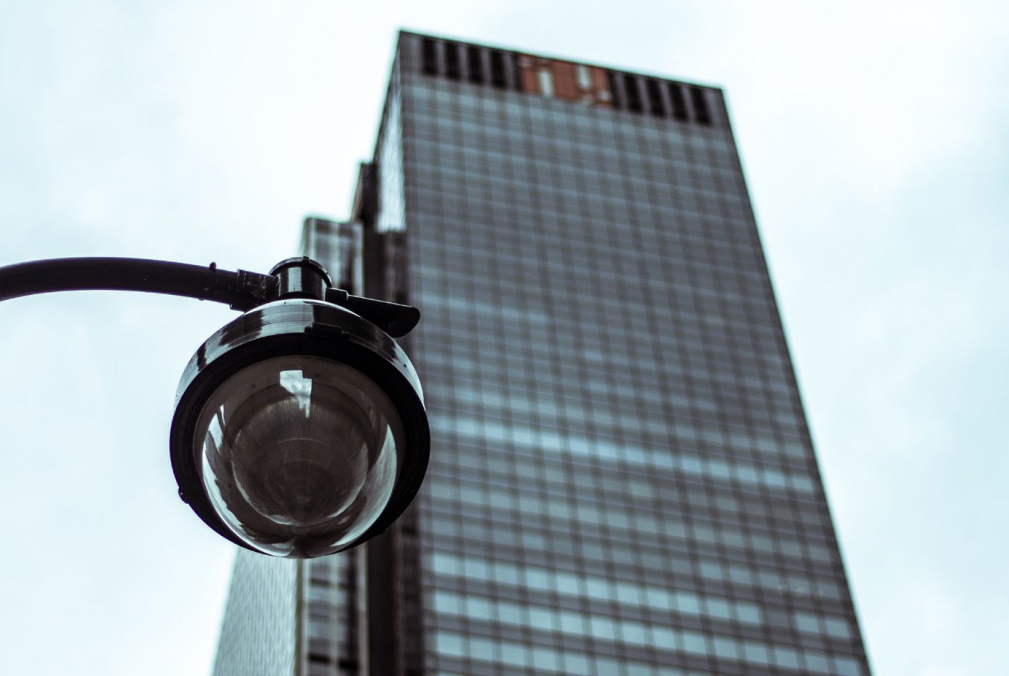
Municipalities are already seeing the huge potential IoT will bring to building management, from energy efficiency to more cost-effective operations. The various systems of a building – ventilation, climate control, lighting, fire protection, video surveillance – have long been doing their jobs in solitude. In a smart building, though, these various systems feed into a central control and instead of working separately, begin to work in a complementary way, such as a sensor that detects a lack of activity in a particular office sending that information to the central control system, which in turn adjusts lighting and temperature systems accordingly.
Additionally, data generated by smart buildings can trigger changes in facility management that in turn reduce energy consumption in a number of ways, while also saving money, optimizing processes, and even raising property values. Here’s how:
Lighting accounts for approximately 30-40% of a building’s energy consumption. Smart lighting uses advanced controls that respond to various factors such as occupancy, time, schedules, weather, or a combination of all of these. Lights can be switched on or off at the right time, and even light levels can be varied depending on individual conditions.
Smart sensors can detect potential failures in the performance of various building systems, as well as the structure itself. This allows these issues to be addressed before they cause expensive outages or dangerous conditions, while also maintaining optimal efficiency.
Smart heating, ventilation, and air conditioning (HVAC) systems use multiple sensors to monitor and control indoor climates. Data analysis leads to optimization of HVAC systems while improving occupant comfort. A smart HVAC system can also limit energy consumption in unoccupied parts of buildings, while also detecting and diagnosing faults, and reducing energy usage during peak demand times.
Smart plug load controls are auto-controlled outlets and power strips that rely on motion sensing, load detection, and scheduling to cut off power to equipment that is not in use. For centralized control, plug load schedules can be programmed into lighting and building management systems for further optimization.
A smart building will have connected security cameras and smart access systems, which ensures that you know who is in the building and when – and can send automatic alerts to authorities when security is breached. Additionally, smart buildings can detect smoke right away and then quickly alert everyone to leave while sending notifications to emergency response teams.
IoT allows you to track and monitor office equipment, including copiers, computers, elevators, and even desks. This lets building managers know when repairs are needed, when something has gone missing, when something needs to be replaced, or which machine is so power-hungry it needs to be re-evaluated.
Smart window systems manage the amount of sunlight – and thus solar heat – that enters a building. Auto-controlled window shades can be scheduled to operate at specific times to control light levels and solar heat gain, and active window glazing/film can respond to changes in sunlight or temperature in real-time.
Visibility into a building’s performance data is quickly becoming a differentiator on the property and leasing markets. Both buyers and tenants want smart technology that reduces costs, optimizes energy consumption, and increases security.
While there are numerous smart technologies that can enhance a building’s performance while reducing costs and energy consumption, you don’t have to do it all at once. Like everything with IoT, it’s better to understand which particular challenge you want to address and then build from there – in other words, crawl, walk, run. Every step you take in creating a smart building will enhance your operations and address the goal of greater efficiency. Implement the solution, collect the data, and make continuous adjustments as you move forward.
Read the Tele2 IoT article How IoT is Transforming Building Automation for further insights. And our case with Daikin explores HVAC systems and sustainability gains.
Healthcare experts say we are approaching a time where basic healthcare will be out of reach for millions of people, even as populations age and chronic diseases rise. The good news is the massive potential of IoT is already being realized when it comes to diagnostics and disease management.
Safety and efficiency, empowering patients, and enabling person-centered care are among the benefits of IoT-enabled healthcare, along with disease management, remote clinical monitoring, and preventive care. And with the world living through a global pandemic, IoT-enabled healthcare is more crucial than ever.
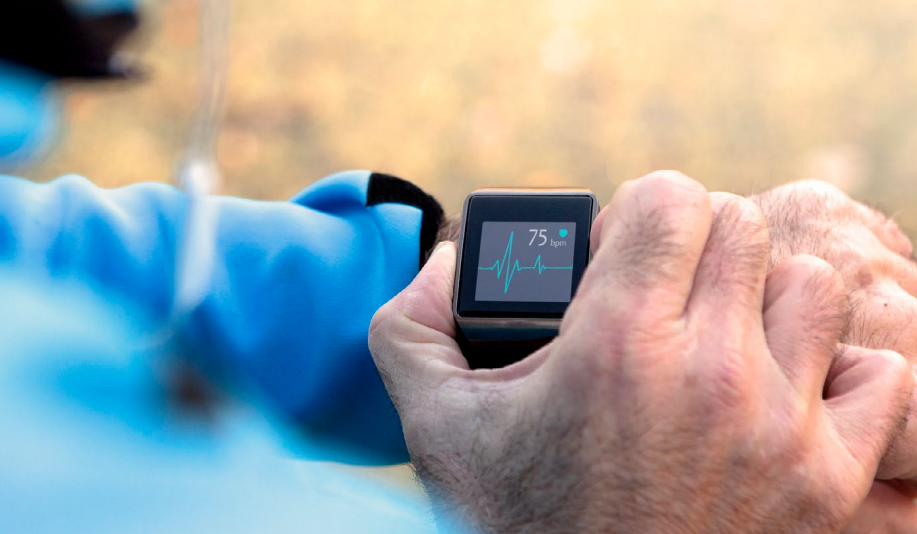
Healthcare today is facing ever-increasing challenges. Services are costlier than ever, populations are ageing, and the number of chronic diseases continue to grow. Throw in a global pandemic that is straining resources to the breaking point, and it becomes clear that something needs to be done. While technology can’t solve all the problems – people will keep ageing and disease will never truly go away – it can make healthcare more cost efficient, more accessible, and easier to deliver. Even if some hurdles remain, connected healthcare is accelerating.
IoT has already brought significant changes to patient care. Healthcare providers have been able to streamline delivery of care in a variety of ways, saving time and money, and leading to increasingly positive outcomes. IoT-enabled healthcare includes patient monitoring, wearables, smart devices, medical supply chain, and remote care. Resources are put to better use, patients have improved contact with their healthcare provider, and pressure is reduced on already-overtaxed medical workers. While there are myriad advantages to IoT-enabled healthcare, these are some of the areas where IoT has changed healthcare forever.
Before IoT came on the scene, interaction between doctors and patients was mainly through office or hospital visits, and to some extent, phone calls, texts, and emails. There didn’t exist a way for doctors to continuously monitor patient health and respond accordingly. Today, IoT-powered patient monitoring systems and devices are transforming and redefining the delivery of healthcare and everyone is winning: patients, families, physicians, and medical centers.
Remote monitoring keeps patients safe and healthy while also allowing physicians to deliver faster and better care.
It increases engagement and satisfaction, because interactions become easier and more efficient, and costs are kept down.
In 2019, there were roughly 722 million connected wearable devices globally, a number that has more than doubled in the space of three years and making them the second most popular use of IoT technology. Wearables such as fitness bands and wirelessly connected devices that monitor things like blood pressure, heart rate, and glucose levels allow for higher clinical efficiency and better patient monitoring. Doctors are able to perform remote monitoring on patients while receiving live feedback through utilization. In other words, through the use of connected devices, it is possible for healthcare providers to create a system of proactive management, and by providing continuous, non-invasive, and accurate monitoring, issues can be tackled as they arise, well before there is an emergency situation.
Connected devices also give patients access to personalized attention and can be fine-tuned to monitor and remind patients about everything from calorie counts and exercise levels to blood pressure variations and even appointments, whether remote or in person.
By using wearables as well as IoT-enabled home monitoring systems and equipment, physicians can keep track of patients’ health more effectively, allowing them to be more watchful while also identifying the best treatment in order to reach expected outcomes. Additionally, wearables can collect vast amounts of anonymous data that can then be used to advance medical research in ways we’ve never previously been able to imagine. Even further, inserted IoT sensors are on the rise, which can help prevent heart attacks and seizures, as well as provide medical assistance to critical patients in a timely manner.
Mobile healthcare, also called mHealth, watches and takes care of health via mobile apps on your smartphone. Essentially, your smartphone can become your whole healthcare hub, where you access medical information, contact your healthcare provider with a single tap, and monitor and analyze your own health trends.
There are an estimated 100 thousand healthcare-related apps on the market today, with more than 50% of smartphone users collecting health-related information on their devices. 93% of doctors say mobile apps enhance the quality of patient health.
Mobile healthcare has particular value in underdeveloped countries, where costs are high and accessibility is low, but also where many people have smartphones.
Not only can patients gain access to healthcare providers, governments and other interested parties can monitor and track citizen health through the accumulation of data. We’ve seen exactly how valuable this information can be, both in developed and underdeveloped countries, during the global Covid pandemic.
Among the many apps already in use:
Apps not only monitor your health, they can often be programmed to send emergency alerts in the case of heart failure, asthma attacks, or other medical incidents.
As the result of both declining fertility rates and improved survival rates, the global population aged 80 years or older is projected to increase from 137 million today to 425 million by 2050. This demographic shift is happening all over the world, but Europe is on trend to be impacted the hardest, with people 60 years or older expected to account for 35% of the European population by 2050.
Ageing populations, particularly in the developed world, will have a significant impact both politically and economically – and promise to strain already scarce resources even further.
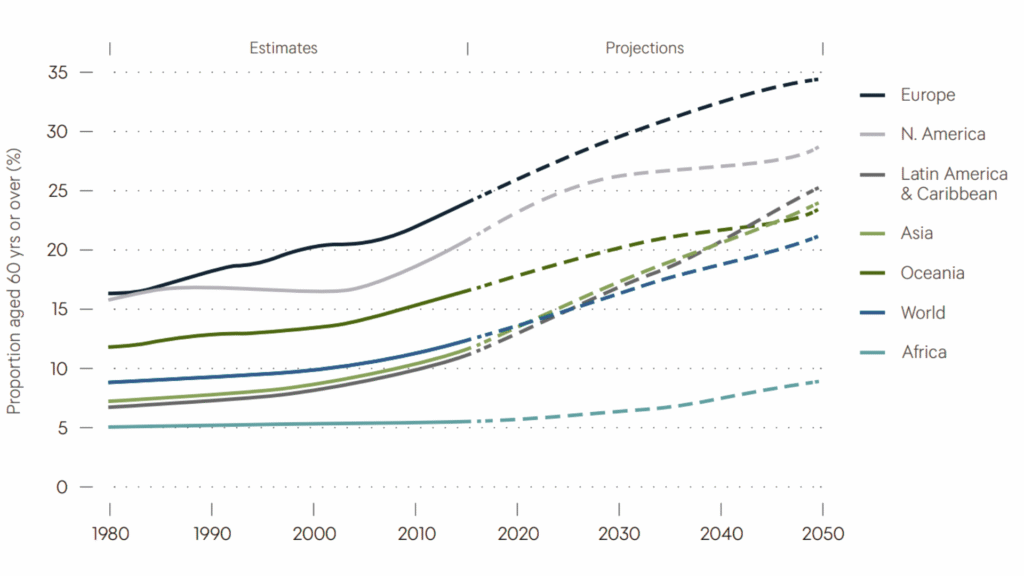
Data source: United Nations (2017). World Population Prospects: 2017 Revision
Seniors overwhelmingly say they would prefer to live fully independently or independently with assistance. IoT devices enable independent life in a number of ways. Motion sensors can be used to alert healthcare professionals if a patient has fallen or has not gotten out of bed, which means help will arrive faster. Wearables mean care can be provided remotely by using data gathered by devices, and a patient’s vital statistics can be continuously monitored and tracked in real-time – which in some situations can mean the difference between life and death. Additionally, IoT devices can monitor everything from medication compliance and blood pressure to heart rate – critical areas when it comes to elderly care.
With the help of increasingly sophisticated and responsive portable diagnostic IoT devices, aging individuals are able to comfortably live in their own homes with much less need of in-person care. But this doesn’t mean loss of communication: IoT-enabled technology, such as virtual home assistants, are changing how seniors communicate. Video calling allows patients to have regular contact with care givers while cutting back on unnecessary trips to their healthcare provider. Additionally, through video calling healthcare providers can give instructions, conduct wellness checks, and include concerned friends and relatives.
While IoT healthcare applications are generally applicable to the general population, they are of particular value when it comes to elderly care, the fastest growing segment in healthcare.
With the implementation of IoT technologies, patients no longer have to always go the doctor’s office or medical center. Patients can be examined by doctors without ever leaving their homes. Remote patient monitoring, as described above, facilitates patient care and the flow of essential medical data.
Monitoring devices collect information on things like vital statistics, medication adherence, and even sleep patterns – something that is particularly important given the rise of sleep apnea. For example, in the past, getting a diagnosis for sleep apnea meant spending the night in a sleep lab, an awkward and artificial environment. IoT technology now allows patients to collect the necessary data while sleeping in their own home. This improves the quality of the data and increases the engagement of the patient in their own care.
In general, remote patient care has a big impact on patient engagement because patients who are directly involved in tracking their own statistics are demonstrably more aware of their health and habits, which improves compliance.
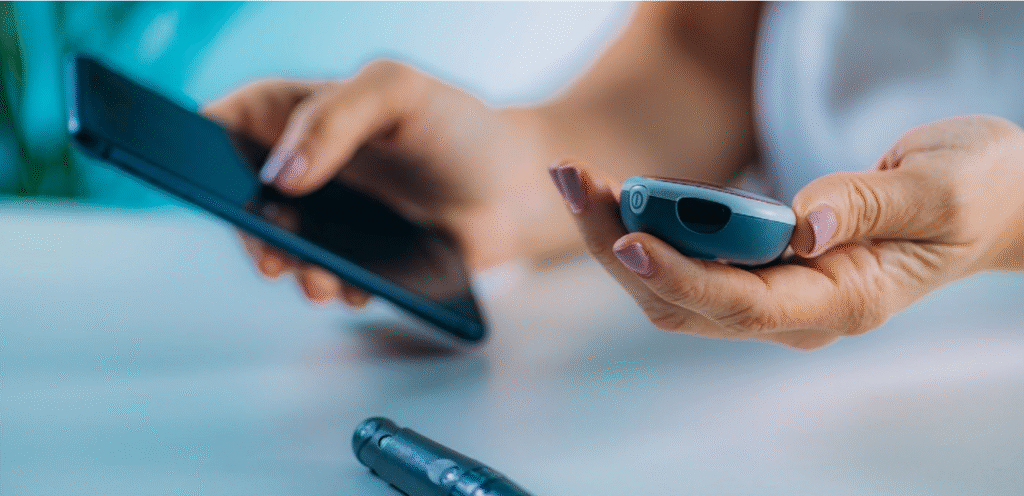
Hospital staff often spend an unacceptable time on manual work, rather than focused on patients. IoT is leading the charge in changing this through a variety of means, including everything from streamlined processes to real-time monitoring of the entire medical center setting.
On a practical level, sensors can be used to track the real-time location of medical equipment such as wheelchairs, oxygen pumps, nebulizers, defibrillators, and various other monitoring equipment. Medical staff can also be analyzed in real time, ensuring the best use of their services.
Additionally, IoT-enabled hygiene monitoring systems can prevent the spread of infection. We naturally expect a hospital to maintain a certain level of cleanliness, even if it’s as simple as a healthcare provider washing their hands regularly, but compliance with handwashing standards can be below 40%.
IoT-enabled hand hygiene compliance monitoring systems ensure proper protocol is followed when it comes to hand washing, thus reducing infections and disease transmission.
There are a number of other ways hospitals and medical centers are using IoT to increase efficiency: connected devices are being used for asset management, such as pharmacy inventory control. Environmental monitoring, such as humidity and temperature, can also be utilized. And wireless sensors in refrigerators are utilized to ensure the proper temperature of blood samples and medications, reducing the need for manual monitoring, while IoT-enabled automation is used to deliver medication through infusion pumps, cutting down on the time staff spends on this.
IoT is having a profound impact on healthcare, and in the wake of the global pandemic, the benefits are becoming even clearer. Connected devices allow continuous patient monitoring and many advances within the sector have led to older and more vulnerable patients in particular to live fuller lives. Doctors are able to confer with specialists across the globe in real time, and in-office visits for patients with chronic diseases are being reduced. Hospital costs are also being reduced and medication is more easily monitored. And most importantly, data collection has improved research and the sharing of information.
For further reading on how IoT is impacting healthcare, our case with Cuviva looks at remote healthcare, while our case with 9Solutions looks at how IoT has enabled a unique Covid-19 response.
As city populations increase, the impact of traffic and congestion on cities will also continue to grow. And while no one likes to sit in a traffic jam any more than they like aimlessly driving around looking for an available parking space, that will be our reality if the problem of congestion isn’t addressed. And congestion is not only inconvenient for commuters – it costs billions in lost time and wasted fuel. Even further, congestion leads to a higher incidence of traffic accidents while also slowing response times. IoT, though, is already being implemented in cities across the globe, optimizing parking spaces and enabling better traffic management.

Recent studies have shown traffic and congestion have a major effect not only on a city’s overall greenhouse gas emission, but also on the mental and physical health of urban residents. Investing in smart mobility technologies such as IoT can not only reduce the toll of traffic and congestion on the environment, citizen health, and quality of life, it can also reduce costs related to traffic accidents and the ensuing response.
Using IoT technology to address traffic and parking congestion benefits cities by:
IoT-based sensors in parking garages combine with real-time CCTV feeds to provide information about vacant parking spots. This information can then be relayed to drivers via an app, reducing the amount of time spent driving in circles looking for a place to park. Additionally, connected parking spaces can be optimized, meaning if someone rents a parking space in the city but only uses it during the day, it can be offered to other drivers at night or on the weekends. Connecting and optimizing parking spaces also reduces the need to create more spaces in our already overcrowded cities.
Traffic lights that rely on real-time data feeds improve traffic flow. IoT sensors collect data about high traffic hotspots, analyze it, and then send drivers information about what to avoid while offering alternative routes. Data can be used to direct drivers to available parking, and also assist long term planning, such as where roads need to be widened or the timing of traffic lights adjusted. There are also solutions being developed that integrate smart, real-time traffic signal control with emerging connected vehicle technology.
Machine vision cameras identify cars within video footage and count the number of vehicles, giving city traffic managers a bigger picture of how traffic is moving, allowing for real-time responses to conditions. Having this technology at smart intersections allows for 24/7 measurement, and the data provided allows cities to make small changes and then measure their impact, iterating until congestion improves. Furthermore, CCTV, in combination with road sensors, can identify accidents and other emergencies, sending location and other relevant information, such as best available route, to first responders, leading to better outcomes.
Smart lights equipped with environmental sensors can adjust in response to current light conditions, increasing safety on the roads. Road sensors can also identify structural issues, such as bridges that need repair or roads that need to be repaved. Addressing these problems early reduces the length of road and bridge closures, which are themselves big contributors to congestion and traffic.
Nobody likes sitting in traffic – according to studies it is rated as one of the least pleasant things to do. But traffic and congestion aren’t just irritating time wasters – they can also impact public health.
To start, traffic and congestion are key contributors to urban air pollution, with transport making up 26% of city emissions. Pollution can provoke and exacerbate long-term respiratory problems such as asthma, and research shows that traffic-related air pollution plays a causative role in premature death, particularly from heart attack and strokes. The European Environmental Agency estimates that air pollution causes roughly 400 thousand premature deaths annually in Europe.
The negative impact of traffic on public health extends beyond pollution, though. Studies show that the psychological toll we experience while in traffic stems from a sense of helplessness, with respondents saying they would trade five minutes of any leisure activity in order to spend one minute less in traffic. Stress and anxiety don’t just ruin your day, they can lead to or exacerbate other health conditions, such as high blood pressure.
Along with the amount of fuel – and thus money – that is wasted sitting in traffic, being stuck in a traffic jam also makes people late for work, children late for school, delayed deliveries, etc. And being late can cost money, both directly and indirectly.
Workers waste what could be productive time in traffic, while the overall stress and anxiety can impact overall productivity over time. If the stress gets too much and people get tired of dealing with daily congestion, they may move away from the city and even their jobs. This means less revenue flowing into the city, companies losing valuable workers, and the ability to attract and retain talent can decrease.
Tourism is also impacted: if people feel like traffic will be an issue, they may forego attending events or visiting a particular city. And being known as a city with bad traffic isn’t going to help the city’s reputation amongst tourists, resulting in bad word of mouth and poor online reviews, as well as the resultant loss of revenue.
Smart traffic and parking solutions benefit everyone living, working, and commuting within a city. They increase safety, reduce public health threats, and make better use of city resources, while also reducing fuel consumption and the impact on our environment.
To learn more about how to streamline parking in your city, please read our case about how Sweden’s west coast city Gothenburg is using IoT to streamline parking.
Intense climate-related disasters – storms, floods, droughts, heat waves, etc. – are on the rise globally, while at the same time the concentration of greenhouse gasses in the atmosphere is increasing. Temperatures overall are higher than average – and they are becoming more extreme. All of this means that as cascading disasters increase, the role played by local, regional, and national governments needs to evolve. Furthermore, the world is currently facing a global pandemic, one that has exposed the fault lines in a coordinated response when sharing knowledge or reducing infection.

If we look at cities, with buildings close together and people living nose-to-nose, particular issues arise in the instance of natural disasters. An earthquake can flatten large sections of a city, leaving untold numbers of people buried or missing. A flood leaves thousands trapped in buildings or stranded on roads with nowhere to flee to as waters rise. A fire can spread quickly, a hurricane can knock the power out, a snowstorm can leave people trapped in their cars.
Whether it’s a natural disaster or a global pandemic, IoT is proving instrumental in handling disasters and emergencies of all kinds, identifying life threatening hazards, giving warnings, maintaining communications, and providing effective support for emergency responders.
Key areas where IoT is crucial include:
Sensors such as thermometers and barometers have been used to measure weather for a long time, but with IoT technology, these devices have gotten smaller, cheaper, and most importantly, connected. Strategically deployed connected sensors provide real-time data on things like wind, air pressure, and humidity, which can be critical when predicting storm strength and path, giving authorities a head start on alerting citizens, protecting property, or evacuating people in good time if need be.
When we look at difficult to predict events, such as landslides and earthquakes, real-time sensor data offers a head start on reaction times, whether that’s a few hours or even a few minutes of warning.
In the case of forest fires, sensors can quickly note heat or smoke and relay that information to emergency responders, saving lives and reducing the impact on the environment.
Beyond natural disasters, connected sensors in things like isolated buildings can send automated emergency calls to emergency teams if smoke or fire is detected, and possibly, depending on the device, provide real-time video of the scene, as well as location.
Embedding sensors and devices into infrastructure makes it possible to monitor data in real-time on everything from roads, bridges, and buildings to energy grids, nuclear power plants, and public transportation. The data provided allows city managers to prioritize repairs and employ preventive maintenance, as well as close unsafe assets. This type of system could make unexpected events like bridge collapses a thing of the past.
When disaster strikes authorities need to alert people in the area about what precautions they should take and any danger that might be heading their way. Connected digital signs, such as at bus stops, on roadways, and in city squares can be used to spread critical information quickly.
When emergency services respond they are consumed with the task at hand, whether that is putting out a fire or rescuing people from the rubble left behind by an earthquake. Smart clothing can report a firefighter’s vital signs, allowing them to be pulled from the scene if it becomes too dangerous. First responders can also be equipped with audio and video sensors, or supported by drones, so that authorities and other team members can assess the situation from afar or if they are on their way to the location.
Deploying IoT-enabled devices that are battery powered and operate and transmit wirelessly means cities can have data network resilience during a disaster. IoT devices can enable limited communication services, such as emergency micro-messaging, when the regular communication infrastructure has been knocked out of service. While disaster resilience is not their primary purpose, employing these devices as an alternative communication infrastructure in locations where there are no other options can mean the difference between life and death.
While IoT technologies can’t stop disasters from happening, they can be instrumental when planning for emergencies, as well as addressing the aftermath. Prediction and early warning systems are greatly enhanced by IoT-enabled sensors, and crucial real-time information help keep both citizens and first responders safe.
To learn more about IoT and disaster management, read our case about cross-border cooperation to address flooding in Central Europe’s Styrian River region.